Whether you call it bubbly, sparkling or fizz, when the unmistakable sound of that cork pops, there will be smiles and celebration all around. However, not all fizz is created equal. The queen of all that sparkles, of course, is French Champagne. As we know, other countries have their own versions, Italian Prosecco, Spanish Cava, as well as British and American Sparkling Wines. All demonstrate varying styles and ways of making.
But let’s go back to where the bubbly first began, in France, where regulations governing production are robust and must be strictly adhered to. They range from the (rightfully) limited use of the name Champagne, to the ‘Traditional’ Method for making it. However, while Champagne may dominate this sector, there is perhaps a slightly less well known but delicious alternative that crosses French regional boundaries more than any other, Crémant.
Nine regions are allowed to make Crémant; Alsace, Burgundy, Jura, Savoie, Die, Limoux, Bordeaux, Loire and one with special dispensation outside of France, in Luxembourg. Made with the same Traditional Method as Champagne (unlike Prosecco which is made using the Charmat Method of pressurizing for the second fermentation). The grapes must be hand harvested. This is not required of Sparkling, Prosecco or Cava (though some makers do choose to do so) and must have a minimum of 12 months (or more) aging in the bottle. However, unlike Champagne, which is confined to using Pinot Noir, Pinot Meunier and Chardonnay, Crémant is allowed to use a wider array of varietals. This means that makers have more freedom in blending and as such each Crémant wine has a unique regional character. For example; in Alsace, Crémant is typically Pinot Blanc dominant. In Loire Crémant is predominantly Chinon and in Burgundy and Limoux it is typically made with Chardonnay, whereas Crémant de Savoie makes use of Jacquère and other varieties to blend.
Similarly, Prosecco primarily uses the regional grape variety of the same name and Cava tends to blend the Macabeo, although Chardonnay has begun to take root in a big way in Spain as well. Another key difference of Crémant versus Prosecco, for example, is in the ‘dosage’ or topping up sugars needed to create the mousse (bubbles). Prosecco typically adds 12-14gr of sugar (which can mask a myriad of defects in production), whereas Crémant Brut typically uses 6-7gr, which creates a drier style wine, much closer in nature to that of Champagne.
You might be thinking, if its bubbly you want, why not just go out and buy some Champagne? Well, for many people, the price of Champagne (which typically starts around £25 per bottle and up) can be a hurdle. However, happily for all of us who like to get fizzy often and regularly with food, Crémant, like Prosecco, starts around the £9 range with higher quality offerings closer to £14 and up. Great value for a good quality fizz.
Interesting blends at reasonable prices make for a fun and entertaining bubbly trip around France in your glass. Cocktail aficionados who like a little bubbly to top off their inspired concoctions may also find that each Crémant region brings something slightly different and interesting to the mix. As for me, when that Crémant cork pops, I’m all smiles with a glass in hand!
Here are a few good ones to try (available from Ocado and others in the UK):
Terroir La Baume Saint Paul, Crémant de Limoux Brut

Lovely golden colour with a fine mousse, lemony citrus and almond notes with good balance.
Francois Martenot, Crémant de Bourgogne

Pale and fresh with lively fruity and slightly floral notes. Great with food.
Arthur Metz Crémant de Alsace Organic Brut

Lovely peach and citrus notes, a fine mousse and long finish.










